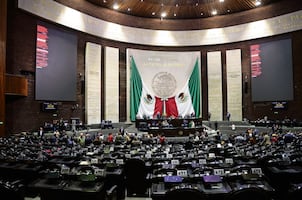Más Información

Alito Moreno afirma que México debe ser aliado de EU ante dictaduras como la de Maduro; "¡Venezuela libre ya!”

Morena va contra “Ley Esposa” en SLP que postula solo mujeres en 2027, señala Alcalde; prepara acción de inconstitucionalidad
Only one year after its opening, the Mammoth Museum , located in Tultepec , Stae of Mexico, will be expanded since the space is insufficient for the over 900 bones of at least 14 mammoths that were found this year in a nearby common land.

The museum, which is part of the Víctor Urbán Velasco House of Culture , has two levels hat comprise a surface of 350 square meters .
By 2020 , it is expected for the municipality to spend approximately MXN $2 million to expand the museum.
Have you heard of the
?
Juana Zúñiga
, director of the project of the Mammoth Museum , pointed out that the municipal government has already approved the expansion of the museum nevertheless, through its Social Communication area , Tultepec said that “the budget will be approved in February . Although there is an estimation of the investment, the project doesn’t exist yet.”
The Mammoth Museum is not new; the project began when, in December 2015 , during drainage works in La Saucera street in San Antonio Xahuento, Tultepec , a mammoth skull with over 200 bones was found.
The municipality sought for the remains not to leave Tultepec, so in April 2016 , the municipal government signed an agreement with the National Institute of Anthropology and History (INAH) for the recovery of the skull.
Usually, every time an agreement of this kind is over, said Zúñiga, the materials are sent to INAH’s storage rooms so the municipality was interested in the fossils to remain in Tultepec.
Did you know the
were found in Tultepec?
2016
marked the beginning for the creation of the museum and the municipality was in charge of the excavation, restoration, and installation expenses for the current venue.
The space was opened on November 29, 2018, with the permanent exhibition “The Tultepec’s Mammoth, a window to the past:” Zúñiga explained that the objective of the exhibition was to open a window of pre-Historical knowledge.
The museum is part of the Víctor Urbán Velasco House of Culture , so the municipality os in charge of the logistics and materials it needs.
According to numbers provided by Zúñiga, during its first year, the museum received over 46,000 visitors that have been able to watch the mammoth skull located in the first level of the venue, where there are also three displays and a store.
The first display contains bones of birds and fish “that show the presence of water in the are.” The second has small bones , while the third has materials donated by people from nearby communities.
Have you heard of the
?
“After the 2016 discovery, people became aware and have returned pieces they have found in different places. There are also two paintings: "Tollintepetl, its pre-Historical Past" , by Albino Luna Sánchez, and "The Pack in the Tule" , by Roque Solano Reyes, both of them were donations,” said Zúñiga.
The store sells t-shirts, caps, containers, and other objects. Next to the store, there is a staircase to the second level where the workshops area is located, as well as the temporal exhibitions area – which actually shows “The Frozen Mammoths,” a photographic series selected by archeologist Luis Córdoba to explain how mammoths in Siberia have been found – and a conference room. All services are free.
On November 6 , it was reported that 824 bones of at least 14 mammoths had been found in San Antonio Xahuento, Tultepec. “Since the discovery was reported, the number of visitors has increased since they want to see the new bones and objects, but they are not here yet, it is an ongoing excavation ; besides, they need restoration, cleaning, and installation processes. Also, new agreements must be reached with INAH, as well as economic resources , although the municipal government has already approved the expansion of the museum,” she asserted.
Have you heard of the Mexican archeologists who found
?
More discoveries
The excavations have continued in Tultepec’s common land and a month after reporting the discovery of the 824 bones, archeologist Luis Córdoba Barradas declared the number has increased.
“In the last month of investigation, we have already registered approximately 900 bones 4 meters deep. The number of mammoths is still the same,” as explained by the researcher of INAH’s Board of Archeological Salvage .
The most recent discoveries were made in the northern part of the land. They found mammoth ribs, vertebrae, and scapulas , as well as two camel vertebrae .
“In total, there are four camel vertebrae and a jaw, as well as a horse tooth, and a pair of bones that have yet to be defined to which animal they belonged,” explained the archeologist .
Nearly 700 bones have already been moved to the Mammoth Museum , however, due to the lack of space of the venue, they had to be put in racks or on the floor of the storage rooms of the Víctor Urbán Velasco House of Culture.
Did you know dinosaurs had
?
mp
Noticias según tus intereses
[Publicidad]
[Publicidad]












